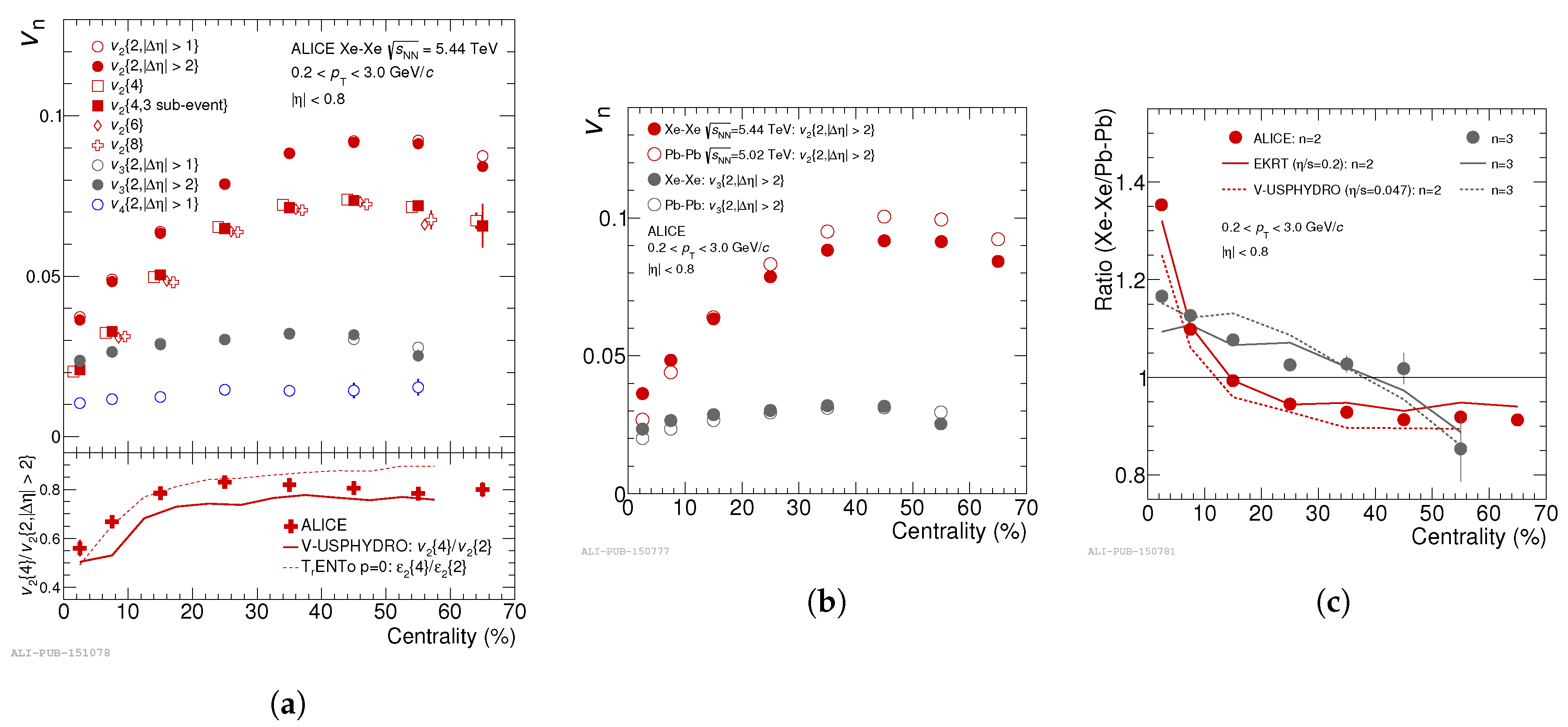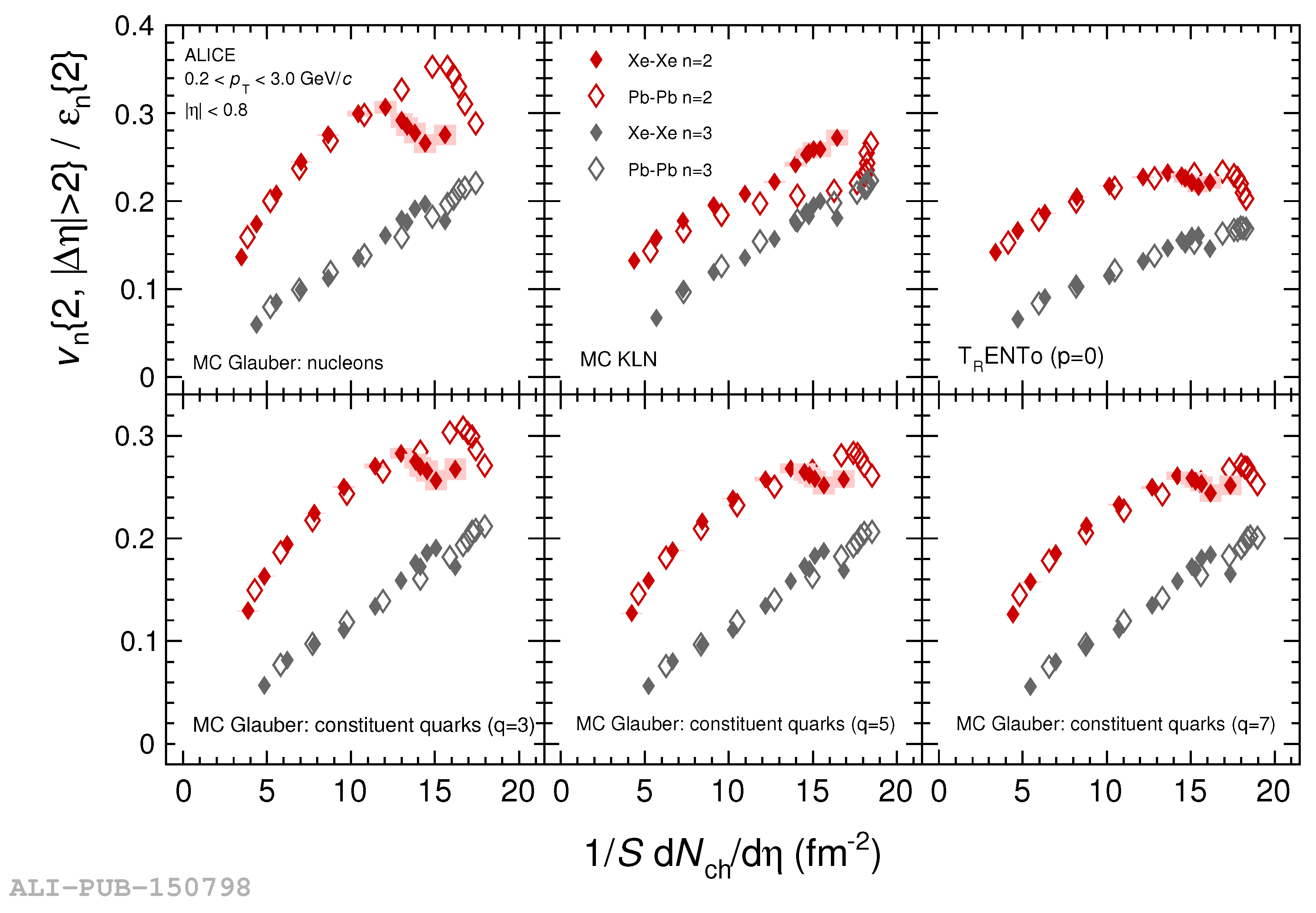Measurements of Anisotropic Flow in Xe–Xe Collisions at √sNN = 5.44 TeV Using the ALICE Detector †
Abstract
:1. Introduction
2. Analysis Methods
3. Results
4. Discussion
5. Conclusions
Funding
Conflicts of Interest
References
- ALICE Collaboration. Anisotropic flow in Xe–Xe collisions at = 5.44 TeV. Phys. Lett. B 2018, 784, 82–95. [Google Scholar] [CrossRef]
- Holopainen, H.; Niemi, H.; Eskola, K.J. Event-by-event hydrodynamics and elliptic flow from fluctuating initial state. Phys. Rev. C 2011, 83, 034901. [Google Scholar] [CrossRef]
- ALICE Collaboration. The ALICE experiment at the CERN LHC. JINST 2008, 3, S08002. [Google Scholar] [CrossRef]
- Bilandzic, A.; Christensen, C.H.; Gulbrandsen, K.; Hansen, A.; Zhou, Y. Generic framework for anisotropic flow analyses with multiparticle azimuthal correlations. Phys. Rev. C 2014, 89, 064904. [Google Scholar] [CrossRef]
- STAR Collaboration. Elliptic flow from two and four particle correlations in Au + Au collisions at = 130 GeV. Phys. Rev. C 2002, 66, 034904. [Google Scholar] [CrossRef]
- Giacalone, G.; Noronha-Hostler, J.; Luzum, M.; Ollitrault, J.-Y. Hydrodynamic predictions for 5.44 TeV Xe + Xe collisions. Phys. Rev. C 2018, 97, 034904. [Google Scholar] [CrossRef]
- Moreland, J.T.; Bernhard, J.E.; Bass, S.A. Alternative ansatz to wounded nucleon and binary collision scaling in high-energy nuclear collisions. Phys. Rev. C 2015, 92, 011901. [Google Scholar] [CrossRef]
- Eskola, K.J.; Niemi, H.; Paatelainen, R.; Tuominen, K. Predictions for multiplicities and flow harmonics in 5.44 TeV Xe + Xe collisions at the CERN Large Hadron Collider. Phys. Rev. C 2018, 97:3, 034911. [Google Scholar] [CrossRef]
- ALICE Collaboration. Centrality and pseudorapidity dependence of the charged-particle multiplicity density in Xe–Xe collisions at 5.44 TeV. arXiv 2018, arXiv:1805.04432. [Google Scholar]
- ALICE Collaboration. Centrality dependence of the charged-particle multiplicity density at midrapidity in Pb–Pb collisions at = 5.02 TeV. Phys. Rev. Lett. 2016, 116, 222302. [Google Scholar] [CrossRef] [PubMed]
- Loizides, C. Glauber modeling of high-energy nuclear collisions at the subnucleon level. Phys. Rev. C 2016, 94, 024914. [Google Scholar] [CrossRef]
- Drescher, H.-J.; Nara, Y. Eccentricity fluctuations from the color glass condensate at RHIC and LHC. Phys. Rev. C 2007, 76, 041903. [Google Scholar] [CrossRef]
- ATLAS Collaboration. Measurement of long-range multiparticle azimuthal correlations with the subevent cumulant method in pp and p + Pb collisions with the ATLAS detector at the CERN Large Hadron Collider. Phys. Rev. C 2018, 97, 024904. [Google Scholar] [CrossRef]

Publisher’s Note: MDPI stays neutral with regard to jurisdictional claims in published maps and institutional affiliations. |
© 2019 by the author. Licensee MDPI, Basel, Switzerland. This article is an open access article distributed under the terms and conditions of the Creative Commons Attribution (CC BY) license (https://creativecommons.org/licenses/by/4.0/).
Share and Cite
Adolfsson, J., , for the ALICE Collaboration. Measurements of Anisotropic Flow in Xe–Xe Collisions at √sNN = 5.44 TeV Using the ALICE Detector. Proceedings 2019, 10, 41. https://doi.org/10.3390/proceedings2019010041
Adolfsson J , for the ALICE Collaboration. Measurements of Anisotropic Flow in Xe–Xe Collisions at √sNN = 5.44 TeV Using the ALICE Detector. Proceedings. 2019; 10(1):41. https://doi.org/10.3390/proceedings2019010041
Chicago/Turabian StyleAdolfsson, Jonatan , for the ALICE Collaboration. 2019. "Measurements of Anisotropic Flow in Xe–Xe Collisions at √sNN = 5.44 TeV Using the ALICE Detector" Proceedings 10, no. 1: 41. https://doi.org/10.3390/proceedings2019010041
APA StyleAdolfsson, J., , for the ALICE Collaboration. (2019). Measurements of Anisotropic Flow in Xe–Xe Collisions at √sNN = 5.44 TeV Using the ALICE Detector. Proceedings, 10(1), 41. https://doi.org/10.3390/proceedings2019010041





